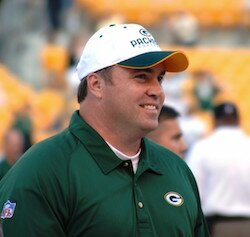 The Packers have rarely had stellar tight ends during Aaron Rodgers’ time in Green Bay. Jermichael Finley was a tight end that could take the top off a defense and last season, Jared Cook was a very nice addition and instrumental in the Packers’ win in the Divisional round of the playoffs. In between have been serviceable guys who do not offer particular advantages. Richard Rodgers has been a good pass-catching tight end but lacks speed and contributes little as a run blocker. All that has changed for the 2017 season, not only in the addition of the big-bodied Martellus Bennett, but the addition of Lance Kendricks to compete with Rodgers gives Packer Nation hope that the team can field two tight ends that can be a threat in the passing game as well as significant advantages for Ty Montgomery and the other Packers running backs. The “12 personnel” is a topic that has come into vogue of late in Packer Nation and with good reason. For the first time, Mike McCarthy, Aaron Rodgers, and the Packers’ offense has a chance to deploy this package (one running back and two tight ends plus two receivers) and within that grouping they can attack the defense in multiple ways. First, let’s talk about the three tight ends that the Packers have and their strengths and weaknesses, then we will discuss a couple ways (among many) in which this new strength of the receiving corps can contribute in the 12 personnel group.
The Packers have rarely had stellar tight ends during Aaron Rodgers’ time in Green Bay. Jermichael Finley was a tight end that could take the top off a defense and last season, Jared Cook was a very nice addition and instrumental in the Packers’ win in the Divisional round of the playoffs. In between have been serviceable guys who do not offer particular advantages. Richard Rodgers has been a good pass-catching tight end but lacks speed and contributes little as a run blocker. All that has changed for the 2017 season, not only in the addition of the big-bodied Martellus Bennett, but the addition of Lance Kendricks to compete with Rodgers gives Packer Nation hope that the team can field two tight ends that can be a threat in the passing game as well as significant advantages for Ty Montgomery and the other Packers running backs. The “12 personnel” is a topic that has come into vogue of late in Packer Nation and with good reason. For the first time, Mike McCarthy, Aaron Rodgers, and the Packers’ offense has a chance to deploy this package (one running back and two tight ends plus two receivers) and within that grouping they can attack the defense in multiple ways. First, let’s talk about the three tight ends that the Packers have and their strengths and weaknesses, then we will discuss a couple ways (among many) in which this new strength of the receiving corps can contribute in the 12 personnel group.
Richard Rodgers
The incumbent, Richard Rodgers is 6’4″ and weighs in about 245 pounds. He is a strong handed, pass-catching tight end that has made big plays for the Packers in the past. No one in Packer Nation has forgotten the “Motor City Miracle” and how much that one catch meant for the team at the time, but the Packers need more out of the position than just the chance to steal one from a team in the last seconds of a ball game. Rodgers is not the biggest, not the fastest and comes off as kind of a “tweener” tight end in the league. There is no doubting his pass-catching ability not just with the Hail Mary pass he caught in Detroit, but in several touchdowns snagged from under the armpit of opposing linebackers. Richard Rodgers can still be a contributor on a Packers team that plays in December at Lambeau, where strong hands trump elite speed. But Rodgers is little more than a placeholder as a blocker. In the Packers week 5 matchup against the Giants, Rodgers was repeatedly called upon to contribute in run blocking duties. Out of the flex position, and also from the inverted wishbone. In a game where the Packers tried (and largely succeeded) to balance the passing game with a solid dose of the run, Rodgers showed that he is a less than adequate blocker overall and was a liability in the run-blocking aspect of his game. This has an affect on the Packers play in December as well since the team will want to be able to establish a ground game and while Rodgers has another off-season to think about it, practice, and improve…he is not the man for that job. Enter Martellus Bennett.
Martellus Bennett
Martellus Bennett brings a significant size upgrade to the Packers’ tight end rotation. At 6’6″ and weighing in at 270 pounds, Bennett has the body mass to take on more than just linebackers. In the week five matchup against the Giants, Richard Rodgers ended up one on one with Jason Pierre-Paul, an exchange that was over quickly with Rodgers thrown aside like a bit of dandelion fluff. Bennett, on the other hand, will not be so easily moved. Pierre-Paul, at 6’5″ and 278 pounds would be up against a guy who, though he is not a specialist in defending against elite pass-rushers, can match him pound for pound. Advantage Packers. Furthermore, Bennett will be a guy that the Packers consistently line up to threaten down the field or in run blocking in our soon to be discussed 12 personnel group.
But Bennett can also get up the field as well and we could see him lined up outside to create mismatches against smaller DB’s in the league. Bennett is not as fast as Cook was but his size and presence, along with Aaron Rodgers’ ability to place the ball, will make quick but sub-six-foot-tall defensive backs draw a sharp breath.
Lance Kendricks
Hometown boy Lance Kendricks is another acquisition who should get a lot of attention in the Packers’ offense this year. Particularly when coupled  up with Martellus in two tight end sets. Kendricks caught 87 balls for 499 yards and 2 touchdowns last season for the Rams. As with Cook…Kendricks has never played with a quarterback like Aaron Rodgers. As with Cook, he could have a fine year. At 6’3″ and 240 pounds, Kendricks ran a 4.57 40 yard dash coming into the league and adds another solid football intellect to the meeting room. Kendricks can’t help but be an improvement on Rodgers’ blocking and I expect the Packers to quickly move to him as the second tight end in the 12 personnel. So let’s talk about 2 ways the Packers will use the personnel package with the assumption that it involves Bennett and Kendricks, though Rodgers will certainly be rotated in as well.
up with Martellus in two tight end sets. Kendricks caught 87 balls for 499 yards and 2 touchdowns last season for the Rams. As with Cook…Kendricks has never played with a quarterback like Aaron Rodgers. As with Cook, he could have a fine year. At 6’3″ and 240 pounds, Kendricks ran a 4.57 40 yard dash coming into the league and adds another solid football intellect to the meeting room. Kendricks can’t help but be an improvement on Rodgers’ blocking and I expect the Packers to quickly move to him as the second tight end in the 12 personnel. So let’s talk about 2 ways the Packers will use the personnel package with the assumption that it involves Bennett and Kendricks, though Rodgers will certainly be rotated in as well.
Alignment 1: spread the defense with symmetry
The first alignment in this personnel group is the single set back with tight ends lined up on either side of the line of scrimmage. If the Packers’ offense can stay ahead of the count and keep themselves in 3rd and short situations…defenses are going to struggle to stop them. This alignment of the 12 personnel group, on a 3rd and short threatens the run and threatens it to either side. It also threatens a short passing game to big tight ends when the linebackers have had to split wider creating a soft-spot in the middle of the field. Now that Ty Montgomery has had an entire off-season to learn the pass protection in our system, he can help out in pass-pro while we have two fast outside receivers and two big bodied tight ends for Aaron to throw the ball to. It will be difficult for defenses to field enough good pass defenders to counter that. If they contribute more resources, they can’t blitz, if they can’t blitz…Ty Montgomery squirts out into the flat for a first down catch as coverage concerns itself with the four receivers.
One of the great advantages of this set is its symmetry. Another is the way it spreads the defense out. Look for this set in 3rd and short and also in the red-zone.
Alignment 2: Stack the tight ends
In the red zone, the field is compressed. Defenses must play stout against the run and can over-commit. Play action can be highly successful if there is a significant threat in the run game. Ty Montgomery has shown that he can find the endzone even in his so-far short stint at running back. Stacking the two tight ends (one in the flex) yields the look of a strong handed approach to getting in the endzone and Mike McCarthy took advantage of this with Cook and Richard Rodgers stacked to make the play-action that much more compelling. But the compressed field doesn’t go away just because the play-action works. So McCarthy, while he can send both tight ends out on the same side has figured out a way to “decompress” the field by slipping the flex tight end across the field on the same side of the line of scrimmage. This causes a traffic jam as linebackers try to switch and communicate across the field while at the same time allowing for a few extra yards underneath to catch the ball and take it into the endzone. McCarthy has worked magic at times with the stacked tight ends and with the addition of Bennett and Kendricks, I think he will go to it more and more.
I have to believe that Mike McCarthy is drooling over the possibilities and all the flexibility he has in the this personnel group now that Bennett and Kendricks are in the house. Both are blocking upgrades to Rodgers and that alone makes the offense dangerous in this grouping. Of course, the one thing Rodgers has over both of the tight end additions is chemistry and plenty of reps with Aaron. That chemistry will have to develop for Bennett and Kendricks (like it did with Cook), but when it does…watch out.
Go Pack!
